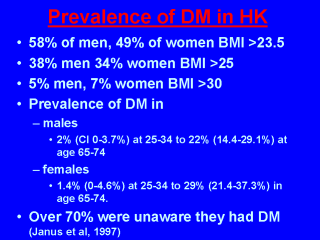| front |1 |2 |3 |4 |5 |6 |7 |8 |9 |10 |11 |12 |13 |14 |15 |16 |17 |18 |review |
 |
A number of
studies have examined the prevalence of these conditions. A recent prevalence study, the
Hong Kong Cardiovascular Risk Factor Prevalence Study (Janus, et al, 1997) found 58% of
men and 49% of women had a BMI exceeding 23.5 (over-weight for Chinese), 38% of men and
34% of women had a BMI >25.0 and 5% men and 7% of women a BMI >30. This study also
found the prevalence of DM increased from 2% to 22% among males aged 25-34 and 65-74 years
of age respectively. In women, the corresponding prevalence was 1.4% to 29% respectively.
Two thirds were unaware they had DM. What do these data tell us? First, around one-in-two of the people surveyed were overweight, one-in-three significantly so, and around one-in-twenty seriously so. Second, DM is seen in up to one in four older people. Why? Activity tends to decline with age, non-lean body mass tends to increase, and as a result circulatory under-conditioning, atherosclerosis, hypertension and other vascular complications intensify. Only three in every ten people with DM knew that they had the disease. Lack of awareness of DM presents the most important barrier to preventing complications. Both patients and the doctor may not know a patient has insulin resistance. Unless DM is considered, screening and preventive strategies will not be used and complications have a greater risk of developing. How common are such complications? |
| front |1 |2 |3 |4 |5 |6 |7 |8 |9 |10 |11 |12 |13 |14 |15 |16 |17 |18 |review |